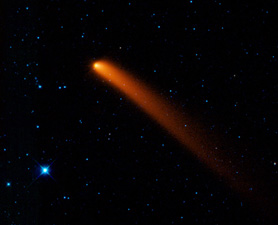
A new infrared telescope has found 16 to 20 previously unknown asteroids that come close to Earth. The asteroids are dark, with most reflecting less than one-tenth of the sunlight that hits them. One object is as dark as asphalt, reflecting less than 5 percent of its light.
The objects, which some scientists suspect may be spent comets, pose no threat to the planet, though how they got here remains a mystery.
"This population tells us a lot about the solar system's history and formation," said NASA's Amy Mainzer, the lead researcher on a project to use a new infrared telescope called WISE to search for near-Earth objects.
The Wide-Field Infrared Explorer, or WISE, has been on the hunt for about seven weeks, mapping the sky for objects that radiate in the infrared. Within six months, WISE is expected to have surveyed the entire sky.
"We're just getting the first data on asteroids in general," Mainzer told Discovery News. "It's still really, really early so we don't have an idea of how big this population actually is."
About half of the newly found objects reflect less than 10 percent of the sunlight that hits them, making them difficult if not impossible to spot with visible light telescopes. WISE finds objects by their heat emissions.
The newly discovered objects have highly inclined orbits, which has planetary scientist Richard Binzel, with the Massachusetts Institute of Technology, thinking that they are comets which have had all their surface ices striped away by heating, leaving just a comet nuclei orbiting in the inner solar system.
Comets are believed to have formed in the frozen outer regions of the solar system, but occasionally some are bumped in closer to the sun due to the gravitational pull of the giant planet Jupiter. As they orbit closer to the sun, ices on their surface vaporize, forming a distinctive fuzzy tail around the comet's body. Binzel believes WISE is finding extinct comets.
"We're constantly finding new stuff," Mainzer said. "We're drinking from the fire hose of knowledge right now. What we've seen is a very exciting glimpse of what is to come."



Reader Comments
to our Newsletter